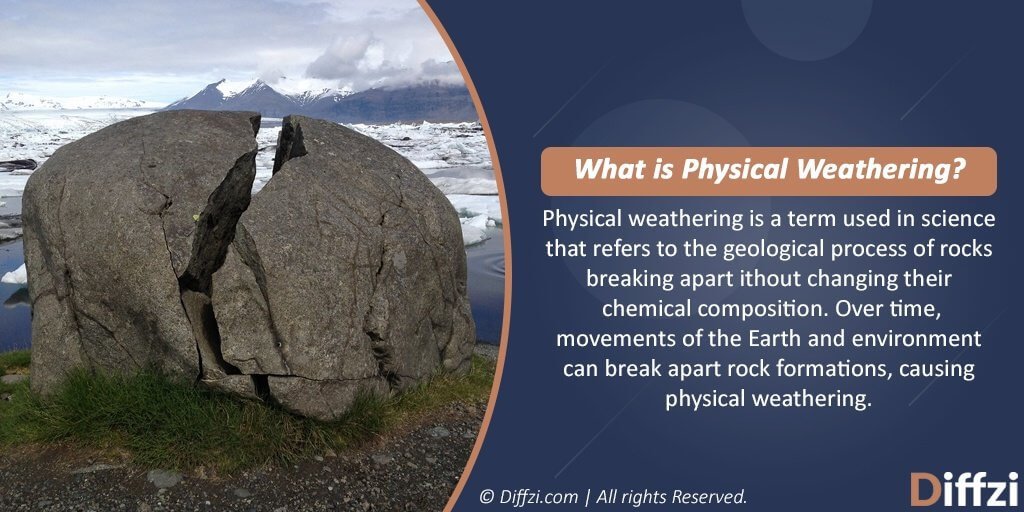The primary difference between physical weathering and chemical weathering is that physical weathering occurs landforms like rocks, minerals and likewise substances are broken down by physical factors in the environment while chemical weathering occurs as a result of changes in the chemical composition of the minerals or rocks from exposure to the environment.
Comparison Chart
| Basis | Physical Weathering | Chemical Weathering |
| Definition | It is the disintegration of rock, mineral and soil aggregates by the mechanical process. | It is decomposition of rock, soil and other minerals by biochemical processes. |
| Environment | Cold and very dry | Wet and hot |
| Effects on Rocks and Minerals | Disaggregation or disintegration of rocks | Decomposition of minerals and rocks |
| Changes | Physical change | Chemical change |
| Agents of Weathering | Pressure, temperature, water, wind, gravity, etc. | Carbon dioxide, water, oxygen, living organisms and acid rain |
| Change in Composition Of Parent Material | No | Yes |
| Stability Of The Rocks | Decrease | Increase |
What is Physical Weathering?
Physical weathering that is also called as mechanical weathering is the disintegration of rock, mineral and soil aggregates by the mechanical or physical processes acting mainly on pre-existing fractures such as cracks between mineral grains and reduces the size of fragments according to the rock and structure of soil without any change in the chemical composition of the rock or mineral. Abrasion is the main process in the physical weathering process. Most of the time physical and chemical weathering often goes hand in hand. However, physical weathering happens because of pressure, temperature, frost and much more. The common examples of physical weathering are cracks in the rocks that are exploited because of physical weathering and increase the surface area exposed to chemical action and ultimately amplify the rate of disintegration. Physical weathering remains happening in the nature all the time. The common examples when water in a stream or river moves speedily and can lift up rocks from the bottom of that body of water. At the end, when rocks get to drop back down again, these collide with other rocks, and then tiny pieces of the rocks can break apart. The other name of physical weathering is disaggregation or mechanical weathering.

What is Chemical Weathering?
Chemical weathering is one of the two types of weathering that tells about the decomposition of rock, soil and other minerals by biochemical processes. It is a biochemical process about weathering pits from where water collects and accentuates rates of chemical weathering. In other words, it can be said as a process that deals with the removal of chemical constituents from rock and results in the generation of new minerals. It is an ongoing and gradual process just like mineralogy of the rocks and minerals that adjust to the near surface environment. In the chemical weathering, hydrolysis and oxidation are the most important processes. The process of chemical weathering is enhanced by the multiple geological agents like oxygen and water and also by the other biological agents like the acids that are generated by the plant-root and microbial metabolism. The degree of chemical weathering differs from rock to rock. For example, in the case of limestone, it occurs readily as compared to granite where it takes some time. Various other factors are also involved in the chemical weathering process. For example, the temperature is another factor that takes part an important role and occurs more quickly in areas of high temperatures. Acid rain is one of the major contributors to the process of chemical weathering when fossils fuels like gas, coal, and gasoline are burnt they release carbon, oxides sulfur and nitrogen into the atmosphere.

Key Differences between Physical Weathering and Chemical Weathering
- Both physical and chemical weathering has four types. The four types of physical weathering are wedging, exfoliation, abrasion and thermal expansion. The four types of chemical weathering are oxidation, hydrolysis, carbonation and acid rain.
- Physical weathering breaks down the rock physical structure while chemical weathering changes the chemical composition of a rock or any mineral.
- Chemical weathering works at the molecular level while the physical weathering works along with mechanical forces.
- Physical weathering expands and contracts the outer layers of rock due to diurnal change temperature when outer layers peel off results granular disintegration. Chemical weathering happens when calcium carbonate dissolves in rainwater.
- Physical weathering happens because of multiple processes like volume changes of minerals, frost wedging and in the end, results in mechanical disruption of rocks. Chemical weathering, on the other hand, is the result of the decay of rock forming minerals caused by temperature, water, hydrogen, oxygen and mild acids.
- Physical weathering is a mechanical process dominates in cold and dry climates while chemical weathering is a process of mineral decay dominates in warm and humid climates.
- Chemical weathering completely changes the composition of rock while physical weathering doesn’t change the chemical composition of the rock at all.
- Chemical weathering of rock mostly occur because of rain while physical weathering happens because of pressure, temperature, snow and likewise other external factors.
- In physical weathering, rock is disintegrated into smaller fragments, but the property of the new remains same as the original one, but in chemical weathering, the internal structure of the rock is altered by the removal or addition of the elements.
- In physical weathering, changes occur because of pressure and temperature. In chemical weathering, changes occur because of the action of chemical agents.
- Chemical weathering increases the stability of the rocks and minerals while physical weathering decreases the stability of rocks and minerals.
- Chemical weathering accentuated in a wet and hot climate whereas physical weathering is most intense in very dry and cold environments.
- Chemical weathering changes the composition of parent material while physical weathering doesn’t change the composition of the parent material.